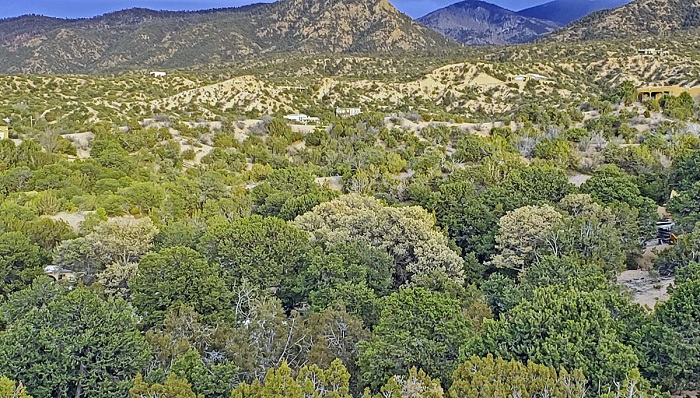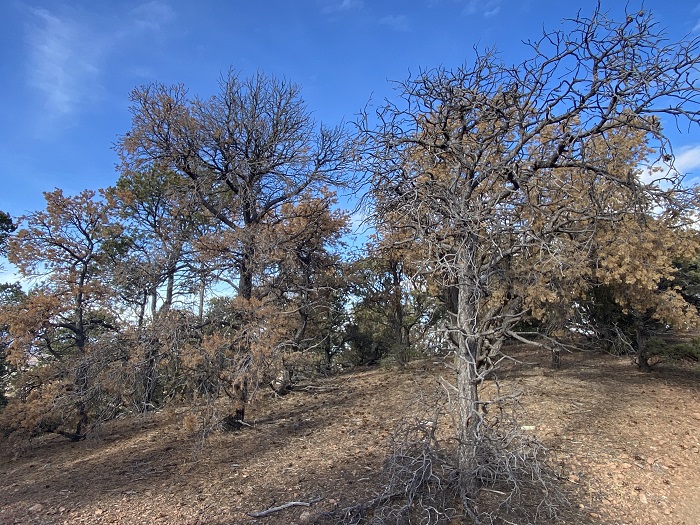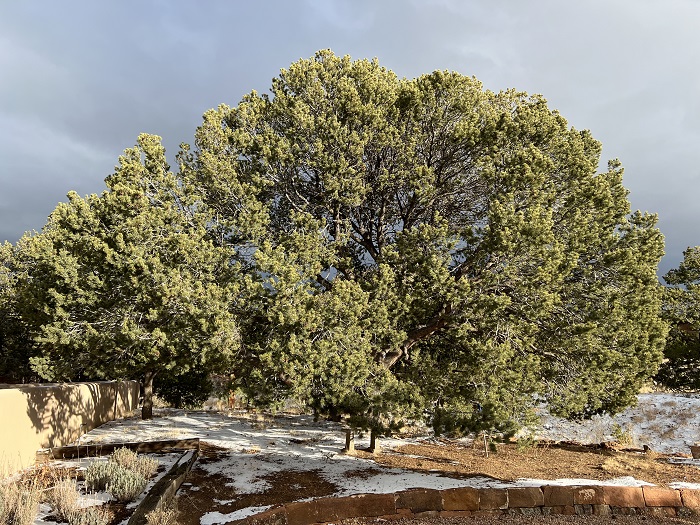December 23, 2021
By Linda Churchill
Maybe we can’t water everything.
As I drive in and around Santa Fe, through the foothills of my beloved Tesuque and down Old Santa Fe Highway on the southeast side, across the mesas northwest of the city and through the corridors to the southwest, it’s the same everywhere: dry dry dry, and piñons (Pinus edulis) are dying.

Dead piñon trees interspersed within a woodland of live ones. Photo by Linda Churchill.
The American Southwest is in the driest 20-year period since the 1500’s. And there are a lot more of us living here now than there were then.
If you want your gardens and trees to thrive in this dry period, you should water more deeply and probably more frequently as long as this drought continues, right? We all know the drill: the best way to assure a healthy, thriving piñon that can fight off diseases and insects is to make sure it is well watered. Ditto many of our other trees and plants, especially natives that evolved in our soils and don’t, generally, need lots of compost and fertilizer.
But what really is the highest, best use for water now in Santa Fe, in the ever more arid West? It might be time for us individually to assess our personal desires for our properties against the greater arc of life on the planet. If you’ve been paying attention, you’ve probably noted that not only are we in a megadrought, but we are also likely moving into a permanently warmer, drier climate in the American Southwest. According to many regional ecologists, piñon pines are likely to dwindle out at our altitude and latitude, due to those permanently drier conditions. We may still see them farther north and, possibly, a bit higher, where ponderosas are now dominant, but if climate change continues its upward average temperature shift, the piñons won’t be here in Santa Fe. Neither will aspens, needless to say.

Dead and dying piñon pines. Photo by Marc Sani.
(So far our other native conifer, the oneseed juniper, Juniperus monosperma, seems to be holding a bit more firmly against this drought than the piñon pine. Our woodland scrub and gambel oaks can be a bit more tenacious too, although we won’t know as much about those until spring.)
But in the meantime do we continue to assiduously water our trees summer and winter, in hope they will stay green, beautiful and pest-free? What if we have three on our property? What if we have thirty, or a hundred?
What if this drought becomes so dire that the city (or county) re-instates outdoor watering restrictions? Could your trees or garden live on once weekly watering? What about once a month? What about no watering at all? What if your well ran dry and you were not permitted to drill another as long as the drought continued? There are indigenous people and others in our own state who have to haul in all their water for drinking, cooking and bathing. There are many countries in the world where watering ornamental gardens would be considered preposterous.
How would you feel if the city allowed all public places—parks, public gardens, museums, the Botanical Garden—to continue to water, while private residents were restricted? If the Colorado River can no longer give water to all the states that rely on it, can we all still live here? Do we allow it to run only to the places that are growing our food?
I’m not advocating that level of social engineering, nor that we all stop watering. But since I spend a lot of time watering our beloved Botanical Garden in the winter, I can’t help but ponder all these questions. I hope you will consider them too, as they may all be pertinent now or in our future. Water is truly a precious resource to all life. Spend it wisely. Water your most important tree.
Read Linda’s winter watering article from 2020 >

Beautiful, healthy piñon at a private Santa Fe residence. Photo by Kathy Haq.


